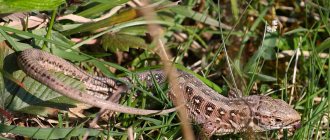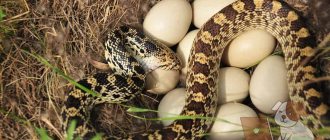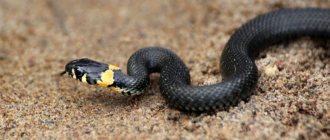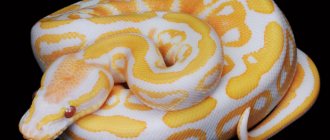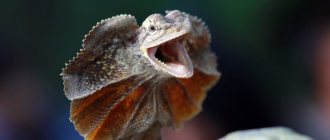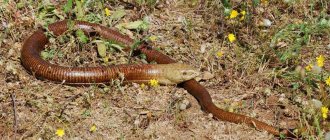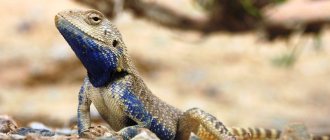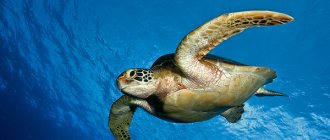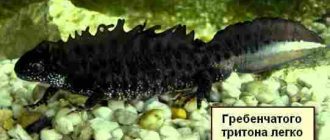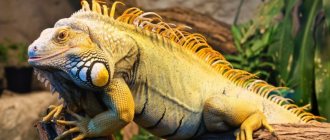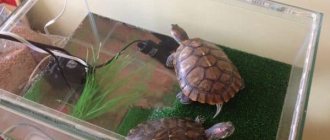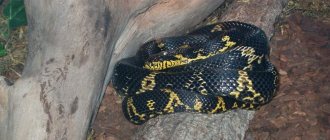One of the most unusual lizards in the world is the blue-tongued skink. This creature is not picky, calm and friendly. It is perfect for home keeping and quickly becomes attached to its owner. Such lizards will appeal to both beginners and advanced breeders. It is possible to breed skinks yourself, although this is not an easy task.
One of the most unusual lizards in the world is the blue-tongued skink. This creature is not picky, calm and friendly.
Natural habitat
The blue-tongued skink is primarily native to Australia, but can also be found in Indonesia and New Guinea. There are regular-sized, dwarf, short-tailed and giant reptiles, growing up to 50 cm in length. In nature, they can run in arid, desert-like areas or mountain forests, wet savannas and coasts.
They do not avoid people; they are frequent inhabitants of backyards and gardens in suburban areas. The animals are generally mobile and can climb trees.
They can live 20 years or longer in captivity if they are well cared for.
Description of the family
The skink family (Latin name Scincidae) are lizards, of which there are up to 1.5 thousand species in nature. A characteristic external feature of the family is smooth scales, visually reminiscent of fish. Skinks' eyes have a round pupil and separate movable eyelids, and the lower one has a fold that allows them to see the surrounding space with “closed eyes.”
They eat a wide variety of foods, are mainly predators, but also consume plants. They reproduce using eggs or viviparity.
The blue-tongued skink (tiliqua - from the Latin Tiliqua scincoides) is a fairly large lizard with a smooth body and a thick tail; in nature there are several species of such skinks. They got their name for the bright blue-violet color of their long tongue, which when protruded can reach a size twice the size of the head. This language is created by nature to frighten birds of prey and other animals that want to hunt the skink.
Appearance Features
At home (terrariums), northern subspecies are more common. Appearance of the blue tongue skink:
- The body is strong, large (50-60 cm) on short legs with 5 fingers on each.
- The tail is more than half the length of the entire body.
- The head is triangular, the eyes with a movable lower eyelid are located on the sides.
- The tongue is blue (or purple). The original coloring of the tongue remains a mystery to scientists. Perhaps the color gives menacingness or with its help it demonstrates superiority and strength to the opponent.
- The jaws are powerful, but the teeth do not look intimidating - they are blunt and are not intended for biting, but for squeezing food. The skink has a secondary palate with sensitive receptors with which the reptile tests the air, as if taking samples.
- Color can be different and depends on the habitat of the reptile: gray and brown shades, as well as yellow, orange and black.
- Scales – very beautiful and elegant, spots and stripes on the body sparkle in the light and form interesting mysterious patterns.
Mr. Tail recommends: varieties
The skink lizard is currently divided into four subfamilies, but scientists believe that this classification will be changed in the coming years:
- Akontieva (Acontinae);
- Ligosomal (Lygosominae);
- Scincinae;
- Blind (Feylininae).
Here are just a few of the most famous and interesting species for exotic lovers. It is believed that blue-tongued, crocodile, and common skinks are more suitable for home keeping, but other varieties are increasingly found in terrariums. All these reptiles delight owners with their obedience, exemplary behavior and ability to quickly tame.
Common Skinks
Pharmacy skinks (Scincus scincus) got their name because in ancient times, the ashes after burning the bodies of lizards were used as a remedy and an aphrodisiac in Arab countries, and in Ancient Egypt, embalmed reptile mummy was buried along with the dead.
The maximum body length of the animal, which lives mostly in the Sahara, other countries of Africa and South-West Asia, is about 20 cm. This Skink is also called sand fish, since the lizard is capable of moving in the desert at speeds of up to 15-20 km/h. The video footage shows that the movements of the reptile resemble swimming, and the sand flows off the smooth scales without scratching them.
Scientists suggest that the micro-protrusions on the lizard's scales have an electrical charge, which are repelled by grains of sand (they are negatively charged).
Short-tailed Skinks
Trachydosaurus or Trachysaurus is a species of skink that also belongs to the genus Tiliqua. This is a variety of the Blue-tongued Australian Skink.
The species was described back in 1825 by the English scientist John Edward Gray. A strong and heavy body with an acute-angled head of brown tones (from light to dark), and its maximum length is 36 cm. They live in the steppes and semi-deserts of Australia. Omnivorous. Natural enemies of short-tailed animals are Dingo dogs and Australian pythons, foxes and cats. Aboriginal people still eat lizard meat today.
The tongue is also blue, but this reptile cannot cast its tail due to its anatomical features; for it it is only a storage of fat reserves.
Giant or Australian Blue Tongue Skinks
Tiliqua scincoides is a large lizard, some representatives reach a length of 60-70 cm. The body is large and strong, of various, often inconspicuous colors, the tail is slightly more than half the length of the body. The paws are short, with five toes. The giant's homeland is deserts, semi-deserts, steppes, savannas, rainforests of Australia, New Guinea, and the islands of Oceania. This species has many subspecies with different biotypes.
They are omnivores, but prefer plant foods. They lead a diurnal lifestyle, but in the hottest times they try to find shelter in holes, cracks, and tree trunks. This is a territorial species, actively protecting its habitat, although in other cases it is peaceful.
In appearance, gender differences are not visible. They can be identified only by the behavior of individuals during the mating season - the male holds the female by the neck with his teeth during mating (September-November).
The subspecies most often kept in captivity has a dark brown body background with bright orange patterns. The oral cavity is deep red, and the color of the tongue is deep blue to purple. Life expectancy is up to 20 years.
These pets are smart, recognize the owner, recognize their nickname and some commands. They are very affectionate and love to be held and petted. You can even walk outside with these Skinks. They behave calmly in the house, sleep at night and do not bother anyone. For keeping, it is better to choose lizards of different sexes or one lizard, since two males can quarrel over territory.
Crocodile skinks
The body dimensions of this lizard are small - 17-19 cm. But the head is disproportionately large in relation to the body, which makes it look like a miniature dinosaur or dragon. A ridge of four rows of bone plates with needles runs along the ridge. The upper part of the body is brownish in color, and the abdomen is much lighter. The bulging large eyes are surrounded by orange rings, which gives the variety its name. This color is characteristic of crocodiles.
The lizard's homeland is the islands of Papua New Guinea. They settle near bodies of water in tropical rainforests and coconut groves. They swim well, so it is necessary to provide a small pond in the terrarium. These mini-crocodiles do not tolerate temperatures above +30 ° C, they are in a hurry to dive into the water, and can even move along the bottom.
The paws are quite long with five thin toes. The reptile can cast off its long tail.
Males are larger than females and have larger heads. The toes on the hind legs are coarser, and on the abdomen there is a corpus callosum for copulation.
They are capable of making sounds and can frighten with their sharp screams. In addition, they like to pretend to be dead. They are nocturnal, so they must be kept in a terrarium; they should not travel alone around the apartment; these Skinks run quickly.
Fire skinks
These lizards are from equatorial Guinea, Cameroon, Morocco, Congo, Gabon, Nigeria, and Kenya. They live in the lower layer of humid forests (litter forests), prefer to hide in burrows all day, and are active in the evening and at night.
Their long body (up to 40 cm, most of which is a thick tail) is brightly colored. Usually the back is bright yellow, even golden, and on the sides there is a flashy black and orange pattern, but there are also almost black individuals, without stripes or ornaments. The short legs are glossy, dark, with five toes. The head merges smoothly into the body, like a snake.
These animals are usually sedentary and calm, but if they get scared, they can bite quite hard; their jaws are powerful. This is an omnivorous type.
Sexual dimorphism is very poorly developed; only an experienced breeder can determine it by appearance.
Grain-tailed skinks
A large lizard about 70 cm long, weighing up to 1 kg, an endemic species of the moist forests of the Solomon Islands. A large, heavy body with a large, blunt head is usually dark green in color. The paws are long with well-developed toes, a tenacious long tail and the limbs have the ability to firmly hold on to tree trunks when moving.
Leads a nocturnal lifestyle. Quite calm and peaceful, but actively defends its territory (both males and females). It is herbivorous, but young individuals also eat live protein foods.
Grain-tailed skinks live in stable families consisting of a male and one or two females. These lizards are viviparous; pregnancy lasts from six to nine months and ends with the birth of one, rarely two, cubs. Sexual maturity occurs at the age of one year, when the young Skink leaves the family.
Grown-up individuals are always expelled from the harem, but at the same time they can accept a small orphan into the family group.
The species is included in CITES Appendix 2, as the number of prehensile-tailed skinks is declining from year to year.
As a pet, it behaves very calmly in a large vertical terrarium with many plants and driftwood.
Pink tongue skinks
Hemisphaeriodon gerrardii is an endemic species of tropical eastern Australia. Adult individuals reach a body length of 45-50 cm, but weigh no more than 150 g. There are about 30-33 rows of smooth scales on the body, usually greenish, grayish, brownish shades. The head is large, the long and thick tail makes up half of the body. The paws and slightly reduced toes are well developed. They lead an arboreal lifestyle.
The coloring of each individual is unique, there are stripes and spots on the body, and the color of the scales is such that it allows the lizard to blend in with its environment. But up to 4 months, the coloring is bright - with black and red markings, and the dark blue tongue becomes pink by the end of the first or second year of life.
This is a molluscivorous species that prefers to feed on small snails. Gerardi's gender cannot be determined externally. As pets, they show themselves to be intelligent, calm and peaceful creatures.
Emerald Skinks
These are Indonesian Dasia lizards that live in tropical forests high in trees (from 1 to 6 m). They are divided into four subspecies. The most common in terrariums has a bright green, emerald body up to 23-25 cm long, the belly is lighter, with a bluish tint. There are yellow stripes on the sides of the head and dark stripes on the body. The housing in the house for these creatures must be made vertical, with a height of at least 1 m, since they feel uncomfortable at the bottom, accustomed to hiding from predators in the treetops during the day.
Very intelligent and peaceful creatures that can get along, for example, with Madagascar geckos - they have similar habitat parameters.
They quickly get used to their household and run to the terrarium door when they see a person, expecting food. It is better to keep Emerald Skinks in a male-female pair.
Far Eastern skinks
Plestiodon latiscutatus is a very beautiful small (9-18 cm) and slender lizard that lives on the Japanese Islands and the Kuril Islands. The long tail (up to 15 cm) is usually brighter than the body. If the body is gray, black, greenish, then the tail has an emerald tint.
They usually live along bodies of water, can swim, and prefer to eat insects and small invertebrates, and snails.
In our country, the species is included in the Red Book, is protected by the state and actively reproduces in the Kuril Nature Reserve.
These are diurnal animals that live in damp earthen burrows.
Three-toed skinks
Yellow-bellied three-toed skinks are native to Australia. Moreover, not only their limbs are amazing - small with tiny three fingers and a long snake-like body-tail (up to 18 cm), but also their method of reproduction.
Individuals in the hot southern coastal regions of the continent lay eggs, and in the cold northern regions they are viviparous.
The body is painted in brown, light chocolate glossy colors. These are nocturnal inhabitants of steppes and forests (litter dwellers), leading a nocturnal lifestyle and feeding on insects.
Types of skinks
Varieties of skinks include:
- Ordinary - the most common. Lives in South-Eastern Australia. The length of the body (with tail) is 45-50 cm. This species includes the northern (intermedia) skink, living in Northern Australia, and chimaerea, inhabiting Indonesia. Both species reach a maximum length of 60 cm.
- Dwarf - small in size - about 10 cm.
- Giant - includes 2 subspecies: southern and northern New Guinea.
- Short-tailed skinks are the only skinks that do not throw off their tail in case of danger, since it contains nutritional reserves, while other lizards easily perform this trick. But the short-tailed ones have the most beautiful scales: embossed and convex, dark brown in color with light zigzags.
- Black and yellow is the most unusual species in color: dark on top, and the abdominal part is light yellow.
- Black-temporal - the name is due to the wide black stripes in the temporal region. The body is light cream in color with a pattern of dark stripes.
Maintenance and care
Having caught a reptile you like in a skink nursery and brought it home, you won’t be able to take the animal and domesticate it right away. It will take several days for it to acclimatize, and it is recommended not to disturb the skink at all during this time. As soon as the lizard begins to eat, you can try to tame it. To begin with, no more than 10 minutes a day and preferably over something soft, so that if the animal falls, it does not damage anything.
In order for the skink to live long and please the eye, it is necessary to create all the conditions:
- Housing . For young reptiles, a plastic box or an 80-liter glass terrarium is suitable. But an adult lizard will need a terrarium length of at least 100 cm, a width of 50 cm and a height of 35 cm. And the larger the better, since reptiles mostly run on the ground and climb very rarely. You need to put a drinking bowl inside, stable and shallow, and change the water regularly. There should be holes in the glass lid of the terrarium.
- Heating . It is important for the reptile to have a cool (+24-27°C) and warm (+32-35°C) corner in the terrarium, so that when it gets hot, it can cool down and vice versa. To do this, you need to install a UV lamp in one corner of the container, and in the other - a heating lamp and thermometers next to it. At night you can reduce the temperature to +21°C. Daylight and heating should last at least 12 hours throughout the day.
- Temperature : daytime – +28-30°С, night – 20-22°С.
- Humidity is moderate, should be around 25-35, it should be checked with a hygrometer.
- Decorating a terrarium . High branches should not be installed in the terrarium as decoration; small stones and driftwood lying on the ground will do.
- Soil . It is advisable to lay a synthetic mat, shavings or crushed bark of non-coniferous trees on the bottom as soil (coniferous fumes are pure poison for lizards). Do not use sand and gravel - the skink can eat them, which will kill the animal.
Genera [edit]
Many births, Mabuya
, for example, are still poorly understood and their taxonomy is sometimes controversial, see for example the taxonomy in the western skink,
long-legged skink skiltonianus
.
Mabuya
in particular is currently being divided, with many species being separated into new genera such as
African mabuya
,
Chioninia
and
Asian mabuya
.
Subfamily Acontinae
(legless skinks; 30 species in 2 genera) [22]
- Acontias
(25 species) - Typhlosaurus
(5 species)
Subfamily Egerniinae
(social skinks; 61 species in 8 genera) [23]
- Bellatorias
(3 species) - Corucia
(1 species) - Cyclodomorph
(9 species) - Egernia
(17 species) - Liofolis
(12 species) - Lissolepis
(2 species) - Tiliqua
(7 species) - Tribolonotus
(10 species)
Subfamily Eugongylinae
(eugonhylid skinks; 455 species in 48 genera) [24]
- Ablepharus
(10 species) - Acritoscincus
(3 species) - Anepistosis
(1 type) - Austroablepharus
(3 species) - Caesoris
(1 species) - Caledoniscincus
(14 species) - Carinascincus
(8 species) - Karlia
(46 species) - Celatiscincus
(2 species) - Cophoscincopus
(4 species) - Cryptoblepharis
(53 species) - Emoia
(78 species) - Epibator
(3 types) - Eroticoscincus
(1 species) - Eugongylus
(5 species) - Geomyersia
(2 species) - Geoscincus
(1 species) - Graciliscincus
(1 species) - Harrisoniascincus
(1 species) - Kanakisaurus
(2 species) - Kuniesaurus
(1 species) - Lacertaspis
(5 species) - Lacertoides
(1 species) - Lamprofolis
(14 species) - Leiolopisma
(5 species) - Leptosiaphos
(18 species) - Liburnascincus
(4 species) - Lioscincus
(2 species) - Lobulia
(8 species) - Ligisaurus
(14 species) - Marmorosfax
(5 types) - Menoetia
(5 species) - Moretia
(8 species) - Nannoscincus
(12 species) - Oligosomes
(52 types) - Panaspis
(21 species) - Phaeoscincus
(2 species) - Phasmasaurus
(2 species) - Phoboscincus
(2 species) - Proablepharus
(2 species) - Pseudemoyas
(6 species) - Pygmaeascincus
(3 species) - Saproscincus
(12 species) - Sigaloseps
(6 species) - Simiscincus
(1 species) - Tachygia
(1 type) - Techmarscincus
(1 species) - Tropidoscincus
(3 species)
Subfamily Lygosominae
(skink ligosomid; 54 species in 4 genera) [25]
- Haackgreerius
(1 species) - Lamprolepis
(3 species) - Lygosome
(32 types) - Mochlus
(18 species)
Subfamily Mabuyinae
(Mabuyid skinks; 25 genera) [26]
- Alinea
(2 species) - Aspronema
(2 types) - Brasiliscincus
(3 species) - Capitellum
(3 species) - Chioninia
(7 species) - Copeoglossum
(5 species) - Dasia
(10 species) - Eumecia
(2 species) - Eutropis
(46 species) - Exila
(1 species) - Geremites
(3 species) - Loving
(1 type) - Mabuya
(9 species) - Manciola
(1 species) - Maracaiba
(2 types) - Marisora
(13 species) - Notomabuya
(1 species) - Otosaurus
(1 species) - Panope
(2 types) - Psychosaurs
(2 species) - Spondylurus
(17 species) - Toenayar
(1 species) - Trachylepis
(87 species) - Varzeya
(2 species) - Vietnascincus
(1 species)
Subfamily Sphenomorphinae
(wedge skinks; 588 species in 36 genera) [27]
- Anomalopus
(7 species) - Asymblepharus
(9 species) - Calyptotis
(5 species) - Coeranoscincus
(2 species) - Coggeria
(1 species) - Concinnia
(8 species) - Ctenotus
(102 species) - Eremiascincus
(15 species) - Eulamprus
(5 species) - Foggia
(1 type) - Glaphyromorphus
(11 species) - Hemiergis
(7 species) - Insulasaurus
(4 species) - Isopachia
(4 types) - Kaestlea
(5 species) - Lankascincus
(10 species) - Larutia
(9 species) - Leptoseps
(2 species) - Lerista
(99 species) - Lipinia
(32 species) - Nangura
(1 species) - Notoscincus
(2 species) - Ophioscincus
(3 species) - Orosaura
(1 species) - Papuascincus
(4 species) - Parvoscincus
(24 species) - Pinoyscincus
(5 species) - Prasinohaema
(5 species) - Ristella
(4 species) - Saiphos
(1 species) - Scincella
(38 species) - Silvascincus
(2 species) - Sphenomorphus
(112 species) - Tropidophore
(29 species) - Tumbunascincus
(1 species) - Tytthoscincus
(23 species)
Subfamily Scincinae
(typical skinks; 294 species in 35 genera) [28]
- Amphiglossus
(2 species) - Ateuchosaurus
(2 species) - Barcudia
(2 species) - Brachymelas
(42 species) - Brachyseps
(8 species) - Chalkis
(32 species) - Chalkidoseps
(1 species) - Eumeces
(6 species) - Eurylepis
(2 species) - Feyline
(6 types) - Flexiseps
(15 species) - Gongylomorph
(3 species) - Grandidierina
(4 species) - Khakariya
(1 species) - Janetaescincus
(2 species) - Jarujinia
(1 species) - Madaskincus
(12 species) - Melanoseps
(8 species) - Mesoscincus
(3 species) - Nessia
(9 species) - Ophiomorus
(12 species) - Pamelaescincus
(1 species) - Paracontias
(14 species) - Plestiodon
(50 species) - Proscelotes
(3 species) - Pseudoacontias
(4 species) - Pygomeles
(3 species) - Skillots
(22 types) - Scinkopus
(1 species) - Skincus
(5 species) - Scolecoseps
(4 species) - Sepsina
(5 types) - Sepsophis
(1 species) - Typhlacontias
(7 species) - Voeltzkowia
(3 species)
Feeding
Blue-tongued skinks are omnivores, but to ensure a long and happy life, the food must be selected correctly, the diet must be balanced: fruits and vegetables, insects and small rodents, cockroaches, snails, worms, squid, dandelions, eggs, peas.
The optimal ratio in the diet: half plant foods, 40% protein and about 10% fruits and vegetables.
Adult lizards need to be fed no more than once every 3 days, and young lizards – every other day.
If the reptile stops eating, you need to remove the remaining food. Thus, gradually adjust the portion and understand how much will be enough for the animal. Plus add nutritional supplements for reptiles.
Water should always be available; it is recommended to change it more often, since lizards can not only drink it, but also swim in it.
Water
Clean water should always be available so they can drink it and bathe. Blue-tongued skinks are poor swimmers, so the container with water should not be deep and it was possible to get out of it freely, but at the same time it was not easy to turn it over.
Since they live in semi-arid areas, the air humidity should be low, between 25 and 40%. True, some species tolerate higher values well. Be sure to check the humidity with a hygrometer.
These are excellent lizards for keeping at home, quite peaceful and unpretentious. Observe basic maintenance conditions and they will delight you for many years.
Compatibility with other inhabitants of the terrarium
If you do not plan to breed blue-tongued skinks, then it is ideal to keep them as hermits and not share them with anyone, because they can constantly fight, especially if only males live. The lizard is friendly towards its owner, but it frightens its relatives with its bloated body, loud hissing, wide open mouth and long blue tongue. But male skinks are very picky about choosing a partner and it is almost impossible to breed these animals at home.
Interesting Facts
Some of them lie in the realm of legends:
- The lizard ran for a long time to bring magic ink to its owner for treatment. Her journey was so long that her legs wore out and became short, and her tongue became saturated with paint and turned blue.
- At least once a year, skinks molt, tearing off dead pieces of scales on stones and driftwood.
- The offspring of blue-tongued Skinks are born rarely - once every two years. One female can lay up to 25 eggs.
- The Flail-tailed Skink is viviparous; the lizard is usually born alone and raised by its parents for up to a year.
- These lizards have black and white vision, but its sharpness is excellent.
Possible diseases
Blue-tongued skinks are generally non-sick animals, and health problems occur as a result of overeating. If a female suffers from excess weight, this is an obstacle to the birth of offspring, and if a male is a loss of interest in reproduction. Obesity is a severe stress for reptiles, so the owner must carefully monitor the skink's diet.
You should also not frighten the reptile; it may stop eating and die. To ensure that the animal is always in excellent condition, it needs UV irradiation and vitamin D.
Natural enemies
In the wild, skinks are hunted by:
- dogs/cats (domestic and stray);
- wild dogs dingoes;
- large snakes;
- gray monitor lizard;
- birds of prey (for example, the laughing kookaburra and brown falcon).
When in danger, reptiles behave differently . Some, like the blue-tongued skink, take the usual defensive pose, hissing and puffing up. At the same time, the lizard opens its mouth wide, scaring off the enemy with a blue tongue, which sharply contrasts with the bright red oral cavity.
This is interesting! A desert skink, a desert skink, goes deep into the sand to emerge at a safe distance from the enemy.
Among the skinks, there are also those who are prone to catalepsy: when frightened, they become numb, as if dead.
Return to content
Breeding
Monogamous blue-tongued skinks think about their offspring in the fall. If there was no pair before, they find a female they like. In this case, it is the female herself who does most of the grooming, parading in front of the future father of her cubs. If the couple was formed earlier, the future parents find each other themselves.
For couples to meet, they prepare a separate terrarium, always with shelters, since the female sometimes shows aggression.
Skink pregnancy lasts about 4 months, from 5 to 18 small lizards are born, which almost immediately become independent.
After 6 months, their teeth change and they are now considered adults.
Keeping blue tongue skinks is a real pleasure. These are excellent companions, devoted to their owner and sincerely loving him. Suitable for domestication, peaceful pets that will delight you for many years.
Reproduction
It is quite difficult to obtain offspring of Skinks in captivity. Even an experienced breeder cannot always determine the sex of blue-tongued lizards. But if in a pair one individual climbs onto the back of the other in September-October and holds her neck with his teeth, most likely it is a male and a female.
A couple unites precisely for the mating season and, as a rule, it is monogamous.
To stimulate breeding, individuals need to be housed for a couple of months, environmental parameters slightly worsened (lower temperature), and slightly underfed. When conditions are optimized and the individuals are brought together, they usually begin to actively eat (the female does much more), and then mating occurs. If a female shows aggression, then she is not ready yet.
Australian Skinks are ovoviviparous. After 4-6 months, the female lays an egg and the baby hatches with a yolk placenta. He eats it, and after a couple of days, molting begins and he is ready to feed on his own. Sexual maturity occurs at 9-12 months.
